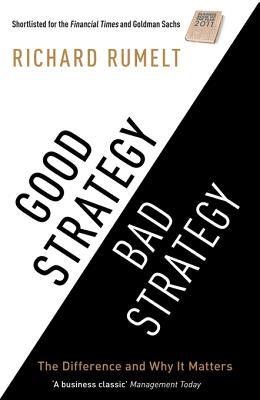More on this book
Community
Kindle Notes & Highlights
thought and action
A diagnosis
simplifies
crit...
This highlight has been truncated due to consecutive passage length restrictions.
A guiding...
This highlight has been truncated due to consecutive passage length restrictions.
overall a...
This highlight has been truncated due to consecutive passage length restrictions.
A set of coherent actions
diagnosing the specific structure of the challenge
creates some type of leverage or advantage.
The core content of a strategy is a diagnosis of the situation at hand, the creation or identification of a guiding policy for dealing with the critical difficulties, and a set of coherent actions.
A great deal of strategy work is trying to figure out what is going on. Not just deciding what to do, but the more fundamental problem of comprehending the situation.
a diagnosis names or classifies the situation, linking facts into patterns and suggesting that more attention be paid to some issues and less to others.
diagnosis is a judgment about the meanings of facts.
Good strategy is not just “what” you are trying to do. It is also “why” and “how” you are doing it.
actions that are coherent, each building on the other rather than canceling one another out.
Product managers were responsible for coordinating activities but had no direct authority. Products tended to be tailored to country or regional differences, partly as a result of some local acquisitions and partly due to perceptions of local differences in tastes.
Well, each country manager has spent years understanding the special conditions in a country, tailoring products and marketing programs to that country’s local conditions. They don’t trust the Pan-European idea. The French don’t want to waste marketing efforts on products they see as ‘too British’ or ‘too German.’ And there really has not yet been a compelling Pan-European product that all could get behind. If it were already a success in three or four countries, the rest would get behind it. But everyone has their current portfolio of products to worry about.
We could have a single group develop, roll out, and market Pan-European products and take full profit responsibility.
Nevertheless, strategy is primarily about deciding what is truly important and focusing resources and action on that objective.
A strategy coordinates action to address a specific challenge. It is not defined by the pay grade of the person authorizing the action.
Strategic coordination, or coherence, is not ad hoc mutual adjustment. It is coherence imposed on a system by policy and design.
leverage, proximate objectives, chain-link systems, design, focus, growth, advantage, dynamics, inertia, and entropy.
Finding such crucial pivot points and concentrating force on them is the secret of strategic leverage.
Most strategic anticipation draws on the predictable “downstream” results of events that have already happened, from trends already at work, from predictable economic or social dynamics, or from the routines other agents follow that make aspects of their behavior predictable.
considering the habits, preferences, and policies of others, as well as various inertias and constraints on change.
identify a company’s strategy,
analyzing qualitative information,
particular mixture of policy and positionin...
This highlight has been truncated due to consecutive passage length restrictions.
When faced with a question or problem to which there is no obvious answer, it is human nature to welcome the first seemingly reasonable answer that pops into mind, as if it were a life preserver in a choppy sea.
Second, growth is the outcome of a successful strategy, and attempts to engineer growth are exercises in magical thinking.
two-pronged pincer movement.
engineering overreach,
smooth-sailing fallacy,
risk-seeking incentives.
social herding.
inside view,
“this case is different.”
An important virtue of a good leader is putting the situation in perspective and having cool-minded judgment.
And there was a belief in the efficacy
The land mania of the 1880s took two main forms. The first was based on a plethora of building societies, whose optimistic officials believed that every family in the colony could simultaneously build their own house, keep up the payments through good times and bad, and support an army of investors who were being paid high rates of interest for the use of their money. The second form of mania was the deeply held belief that it was impossible to lose money by investing in land, a belief that persists to the present day.
The original Jeffersonian ideal was a nation of citizen farmers, each owning the means of his or her own support. Today, this vision has morphed into one of a nation of homeowners, each working 100 days a year to pay their taxes and another 125 days a year to pay their mortgages.


